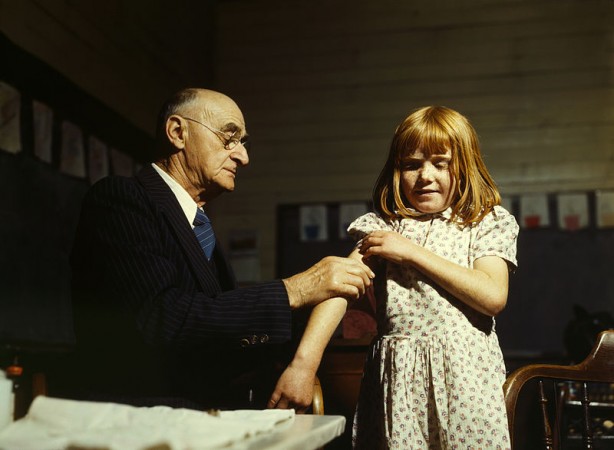
Typhoid, caused by the bacterium Salmonella Typhi, is a significant public health concern worldwide, especially in regions with inadequate sanitation and hygiene practices. This infectious disease can have severe consequences if left untreated, making prevention crucial. In this article, we will delve into the causes, symptoms, transmission, diagnosis, prevention, and treatment of Typhoid fever, shedding light on the importance of proactive measures to combat its spread.
Understanding Typhoid: Causes and Symptoms
2.1 The Bacterial Culprit: Salmonella Typhi
Typhoid fever is primarily caused by the bacterium Salmonella Typhi. This pathogen thrives in contaminated food and water, making ingestion of such substances the primary route of infection. Once inside the body, the bacterium invades the intestinal lining and enters the bloodstream, leading to the onset of Typhoid symptoms.
2.2 Common Symptoms of Typhoid Fever
Typhoid symptoms can be diverse and may initially resemble those of other common illnesses. Patients may experience a gradual onset of symptoms, including high fever, headache, stomach pain, and weakness. As the disease progresses, individuals may suffer from gastrointestinal issues, such as diarrhea or constipation. In some cases, a characteristic rash called "rose spots" may appear on the chest and abdomen.
The Transmission of Typhoid
3.1 Contaminated Food and Water
Typhoid is often transmitted through the consumption of contaminated food and water. This contamination can occur due to inadequate hygiene practices during food preparation or the use of contaminated water for drinking and cooking. Thus, practicing safe food and water habits is crucial to prevent the spread of the disease.
3.2 Person-to-Person Contact
In addition to contaminated food and water, Typhoid can spread through person-to-person contact. Infected individuals can shed the bacterium in their feces, which can contaminate hands and surfaces. Poor hand hygiene and improper waste disposal can facilitate the transmission of the bacteria from one person to another.
Diagnosing Typhoid Fever
Diagnosing Typhoid can be challenging, as its symptoms often mimic those of other febrile illnesses. Physicians may order blood tests and stool cultures to identify the presence of Salmonella Typhi. Prompt and accurate diagnosis is crucial to initiate timely treatment and prevent severe complications.
Prevention is Better than Cure
5.1 Safe Food and Water Practices
Preventing Typhoid starts with adopting safe food and water practices. Boiling or treating water before consumption, washing hands thoroughly before handling food, and consuming only properly cooked meals are essential precautions. In regions with a high prevalence of Typhoid, avoiding raw vegetables and fruits washed with untreated water is advisable.
5.2 Immunization: Typhoid Vaccines
Vaccination is a potent tool in Typhoid prevention. Two main types of Typhoid vaccines are available: the injectable Vi capsular polysaccharide vaccine and the oral live attenuated Ty21a vaccine. These vaccines offer varying durations of protection and are recommended for travelers to high-risk regions and individuals with increased exposure to the disease.
Treating Typhoid Fever
6.1 Antibiotics
Antibiotics play a crucial role in treating Typhoid fever. Commonly used antibiotics, such as fluoroquinolones and cephalosporins, can effectively combat the Salmonella Typhi bacterium. However, due to antibiotic resistance, healthcare providers must choose appropriate medications based on local resistance patterns.
6.2 Fluid and Electrolyte Replacement
Typhoid fever can cause dehydration due to high fever, sweating, and gastrointestinal symptoms. Replenishing fluids and electrolytes is essential to maintain hydration and support the body's healing process.
The Importance of Public Health Measures
7.1 Sanitation and Hygiene
Improving sanitation and hygiene practices is crucial in the prevention and control of Typhoid. Access to clean drinking water, proper sewage disposal, and promoting handwashing can significantly reduce the disease burden.
7.2 Surveillance and Outbreak Control
Surveillance and early detection of Typhoid cases are vital in controlling outbreaks. Timely intervention measures, such as contact tracing and isolation of affected individuals, can prevent further spread.
Travel Considerations and Typhoid
Travelers to regions with a high prevalence of Typhoid should take extra precautions. Obtaining the necessary vaccinations and following safe food and water practices are essential for minimizing the risk of infection.
Typhoid in Children
9.1 Special Considerations for Pediatric Cases
Children are vulnerable to Typhoid infection, and their symptoms may differ from those in adults. Prompt medical attention is crucial for pediatric cases to prevent complications.
Typhoid and its Impact on Global Health
10.1 High-Risk Regions
Typhoid is more prevalent in regions with poor sanitation and limited access to clean water. High-risk areas include parts of South Asia, Africa, and Latin America.
10.2 Challenges in Eradicating Typhoid
Despite significant progress in reducing the global burden of Typhoid, challenges remain. Factors such as antibiotic resistance and limited access to healthcare services hinder eradication efforts.
Typhoid fever, caused by the bacterium Salmonella Typhi, poses a significant threat to public health worldwide. Preventive measures, including safe food and water practices and vaccinations, play a pivotal role in controlling its spread. Early diagnosis and appropriate treatment are crucial to preventing severe complications. By prioritizing sanitation, hygiene, and public health interventions, we can work towards reducing the impact of Typhoid on global health.
Eating these fruits increases eyesight and keeps diseases away
Protecting Your Child's Eyes: Understanding and Preventing Eye Flu Outbreaks in Schools
Hepatitis Set to Surpass HIV, TB, and Malaria Deaths by 2040, WHO Warns